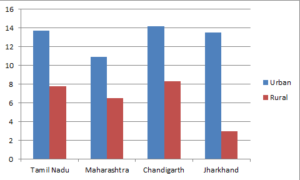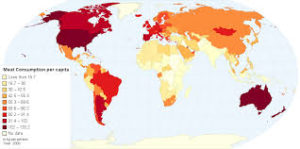India holds the dubious claim of ‘Diabetes Capital’ of the world. Is this claim because of the high absolute numbers as a result of our high population numbers, or is it that we as Indians are more prone to develop the disease?
Let us take a look at the numbers. After all, numbers don’t lie.
The global incidence of diabetes is 8.5% – WHO 2014
According to an Indian Council of Medical Research study over the years 2008-11, in Tamil Nadu, the prevalence of diabetes in urban areas (13.7%) is almost double the rate found in rural areas (7.8%). In Jharkhand, the prevalence of diabetes in urban area is four fold higher than rural areas (urban: 13.5% vs. rural: 3%, In Chandigarh, the prevalence of diabetes in urban is higher than the rates in rural areas (urban: 14.2% vs. rural: 8.3%, In Maharashtra also, the prevalence of diabetes in urban is higher than the rates in rural areas (urban: 10.9% vs. rural: 6.5%, p<0.001) In Chandigarh, the prevalence of diabetes, both in urban and rural areas was higher than in other three regions, viz., Tamil Nadu, Jharkhand and Maharashtra.
Incidence of Diabetes in India in Urban and Rural populations.
Most importantly, during the period 1971–2000, studies from different parts of India reported a 10-fold increase in the incidence of diabetes in urban India (from 1.2% in 1971 to 12.1% in 2000).
This is a very serious concern. Let us try to understand the reasons why this could be happening. If we can identify causes, we are in a position to address solutions.
1 Vegetarianism
India hosts more vegetarians than the rest of the world put together. A 2006 survey by The Hindu newspaper found that 40% of the population comprises vegetarians. Compare this with global statistics: Australia leading the rest at 11.2% and most other countries coming in at 2 – 5%.
How is a dietary preference relevant? What matters is the amount of protein consumed as a proportion of total dietary intake.
Dietary protein consumption per person.
In my personal experience as a doctor of Integrative Medicine, analyzing diets regularly, I find that the figure of 56g/day of protein intake for Indians is highly optimistic; I come across figures like 20 – 40 g/day routinely. This includes ‘non vegetarians’ who do consume some meat. Most Indians do not eat meat daily – there are various abstinence days in the week, and certainly the number of people consuming meat thrice a day is very small indeed.
The reason for this is as much economic as religious. Protein is expensive and in a country where, for a lot of people, a single meal is hard to come by, protein is not a priority.
Now let us examine another graph predicting diabetes rates in the year 2035.

The number of Africans with diabetes is expected to double by 2035, the IDF says. In India an increase of 150% is expected and in Europe the figure is 32%.
Now one more chart depicting carbohydrate consumption as a percentage of total dietary intake.
The countries with darker shade are the ones with highest carbohydrate consumption.
When we look at the three graphs above, we see a clear correlation – the countries with highest carbohydrate intake are also the countries with lowest protein intake and are also the countries with highest diabetes prevalence.
Importantly, what does this tell us? While this is a correlation and not necessarily causation, the trend is clear. A relative excess of carbohydrate intake, combined with a low protein intake, is associated with the development of diabetes. Knowing this we can easily take steps to correct the imbalance by lowering the carbohydrate intake and simultaneously increasing the protein intake.
- Sedentary habits
The first graph above clearly illustrates how diabetes is more prevalent in urban areas. We presume that in rural areas the level of physical activity is higher, even if it is forced. But it has positive side effects!
Learning: Get up and move!! The best way to track activity is to install a pedometer app, which should be easy as nearly everyone has a smartphone nowadays. And aim for 10,000 steps daily.
- Fast food
Double income households means that the old paradigm of women at home, tending to the ‘choolah’, is fast dying out. With that we see the rise of time saving devices like fast food. Although the term is fast ‘food’, the product barely qualifies a food and is sorely lacking in nutrition. It stands to reason that we cannot expect to stay healthy while at the same time eating junk.
- Healthcare expenditure
Clear correlation again. Economic compulsion certainly drives our food choices and health outcomes.
But we are not helpless. We can start moving, taking daily steps. Just a simple walk is enough, an expensive gym membership is not essential. We can maintain a food diary and ensure we take an adequate protein intake. I have reluctantly come to the conclusion that supplementation is inevitable for vegetarians,. And eat clean, healthy food at home.
Consult an Integrative medicine specialist near you for an individualized recommendation.
Diabetes is preventable. And reversible.




